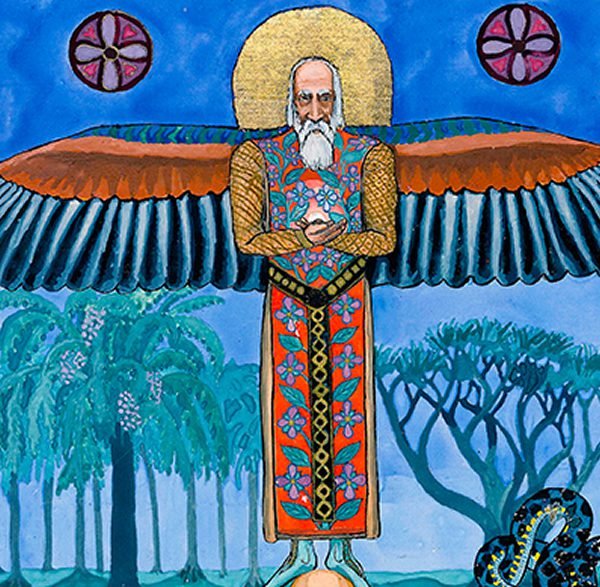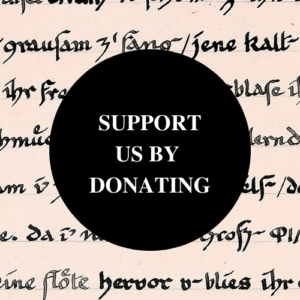The Philemon Foundation is named for a figure that appeared to Jung in a dream in 1913. In Memories, Dreams, Reflections, Jung recounted the dream in which this figure first appeared to him. Jung saw a sea-blue sky covered by brown clods of earth that appeared to be breaking apart. Out of the blue, he saw an old man with kingfisher wings and the horns of a bull flying across the sky, carrying a bunch of keys. After the dream, Jung painted the image, because he did not understand it. During this intense period, Jung was struck by the synchronicity of finding a dead kingfisher, a bird rarely seen around Zürich, in his garden by the lakeshore. Thereafter, Philemon played an important role in Jung’s fantasies.1 To Jung, he represented superior insight and functioned like a guru to him.
Partial accounts of this period may be found in the notes of his seminar given in 1925 on Analytical Psychology (prepared by Cary Baynes) and also in Aniela Jaffé’s biography, Memories, Dreams, Reflections, published posthumously in a heavily edited form. In these, Jung narrated some of his decisive experiences and spoke of a few of the fantasy figures that he had encountered. These fantasies were also from part of the narratives which he recorded in his now legendary Red Book. One of the most significant figures is Philemon.
In his memoirs, Jung reported that he would often converse with Philemon as he strolled in the garden of his lakeside home in Küsnacht, Switzerland. Speaking with Aniela Jaffé, his close friend and colleague, he recalled,
[Philemon] was simply a superior knowledge, and he taught me psychological objectivity and the actuality of the soul. He formulated and expressed everything which I had never thought.
Jung’s fantasy figure was based on the figure of Philemon who appeared in Ovid’s Metamorphoses and in Goethe’s Faust. In the Metamorphoses, Ovid narrates how Jupiter and Mercury went wandering disguised as mortals in the hill country of Phyrgia. Searching for somewhere to rest, they were barred from a thousand homes. However, one old couple, Philemon and Baucis, graciously invited these strangers into their humble cottage. They had been married in this cottage in their youth and had grown old together in it, contentedly accepting their poverty. During the meal they prepared for their guests, the couple noted how their flagon refilled itself automatically as soon as it was emptied. To honor their guests, they offered to kill their only goose. The goose took refuge with the two gods, who decreed that it should not be killed. Revealing themselves, the two divinities informed the ancient couple that those around them would be punished, but that they would be spared. With the gods they climbed to safety on a nearby mountain. Upon reaching the top, they could see that the country surrounding their cottage had been flooded, with only their cottage remaining, now transformed into a splendid temple with columns of marble and a roof of gold. To repay them for their hospitality and kindness, the gods granted the old couple any wish. Philemon and Baucis’s reply was in keeping with their deep humility and reverence. They wished to become priests and serve in this new shrine to the gods and to die at the same time as a testimony to their enduring love. And so it happened, and when they died the gods honored them further by transforming them into trees so that they might continue to live side by side in this way as they had done in their mortal lives.


In Faust 2, Act V, Goethe has Faust build a city on land reclaimed from the sea. In order to accomplish this task, Faust tells Mephistopheles that he wants Philemon and Baucis, who lived on this land, moved. To Faust’s ultimate horror, instead of doing so, Mephistopheles decides to burn their cottage with Philemon and Baucis inside. Goethe’s Faust made a tremendous impression on Jung and held a life-long significance for him. He felt personally implicated by the destruction of these humble and reverent figures and felt that it was his responsibility to atone for this crime and to prevent its repetition.3 Healing this Faustian split would become a central theme in Jung’s life work.
At his tower in Bollingen, Jung commemorated Philemon. Over the gate, he carved the inscription, “Philemonis Sacrum – Fausti Poenitentia” [Philemon’s Shrine – Faust’s Repentance]. In one of the rooms at Bollingen, he painted a huge mural of the winged Philemon, essentially reproducing the painting from the Red Book. In a letter to Paul Schmitt in 1942, Jung wrote: “I have taken over Faust as my heritage, and moreover as the advocate and avenger of Philemon and Baucis, who, unlike Faust the superman, are the hosts of the gods in a ruthless and godforsaken age.”4
1C. G. Jung & Aniela Jaffé, Memories, Dreams, Reflections. Translated by R. and C. Winston, London: Fontana, 1962/1983, p. 207.
2Protocols of Memories, Dreams, Reflections, Library of Congress, p. 23.
3C. G. Jung & Aniela Jaffé, Memories, Dreams, Reflections, p. 261.
4C. G. Jung, C. G. Jung Letters 1: 1906–1950. Edited by Gerhard Adler in collaboration with Aniela Jaffé, translated by R. F. C. Hull, London: Routledge, 1973, pp. 309–10.


